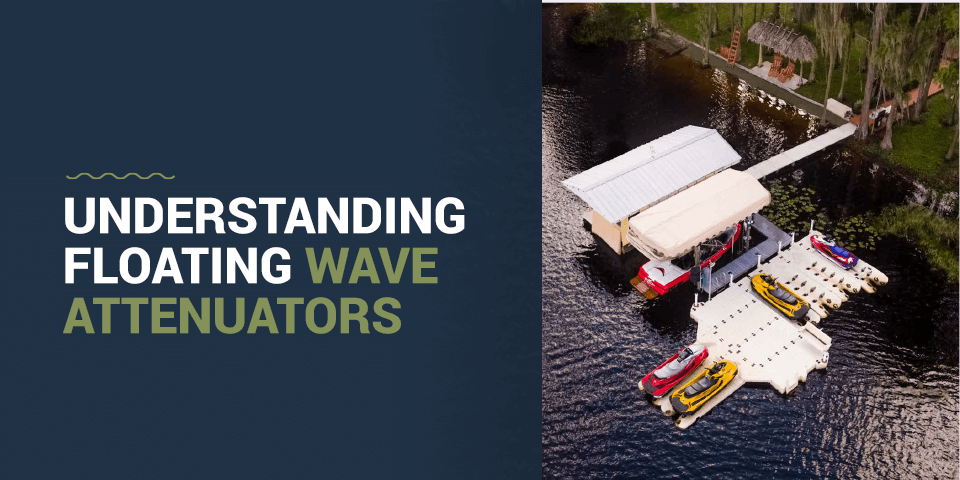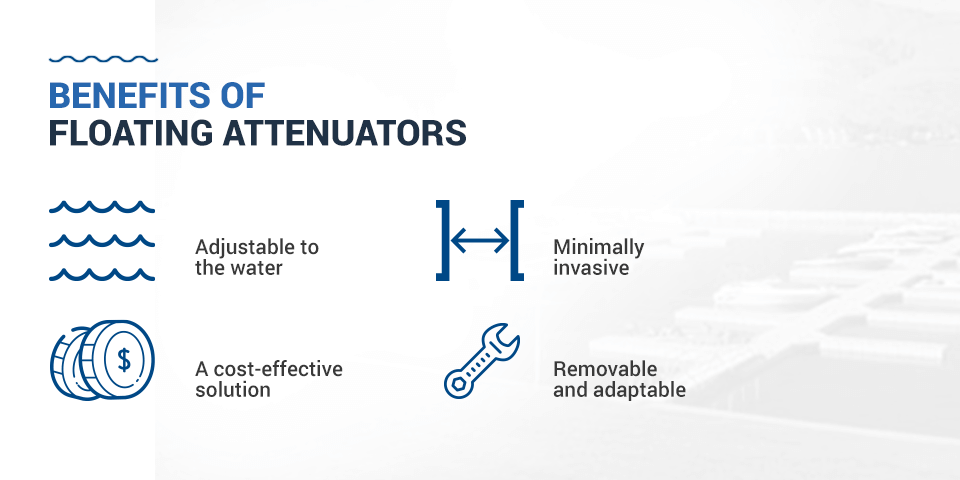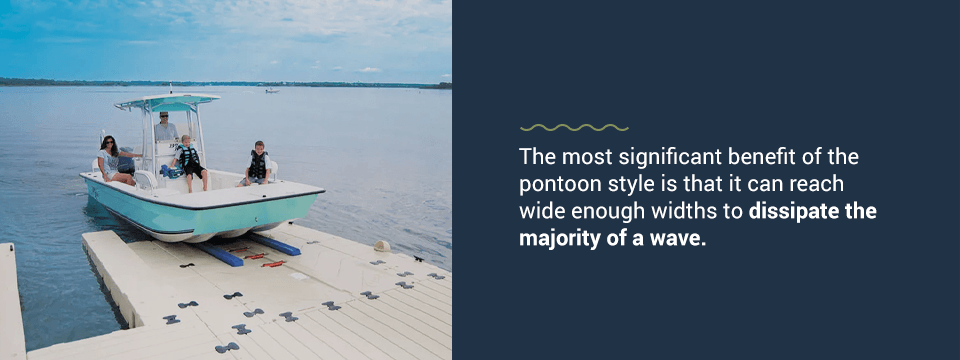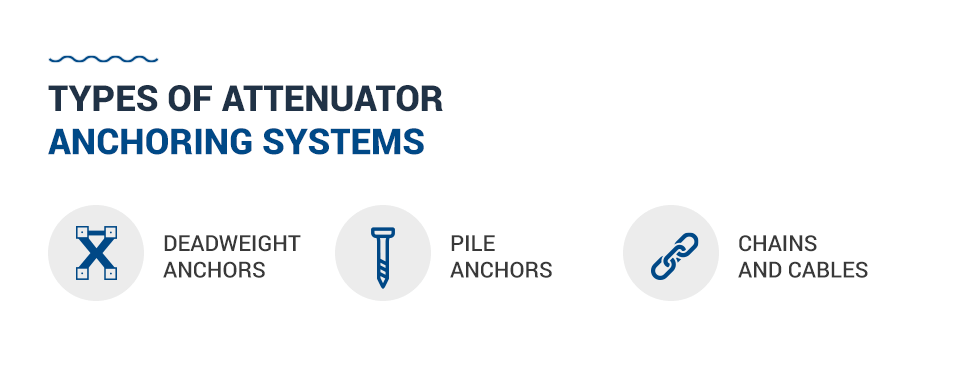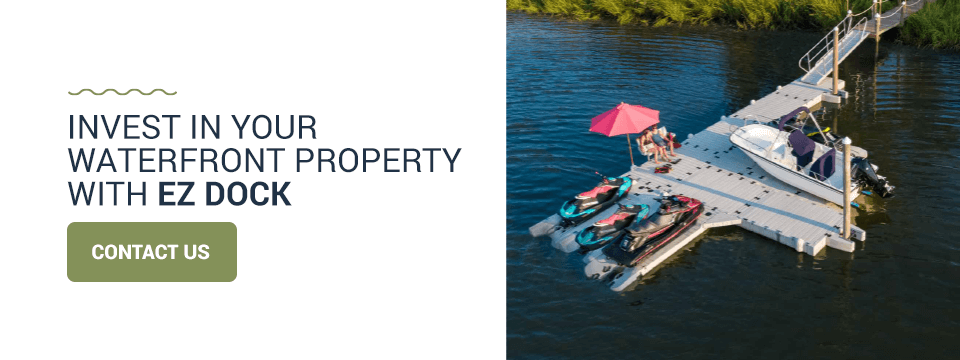Filters
Understanding Floating Wave Attenuators
Wave attenuators are critical in places with vulnerable shores that struggle with erosion or overtopping. Many property owners also use them to increase the value, safety and functionality of their waterfront property. Read on to learn more about wave attenuators, how they work and why your property might benefit from one.
Read the full article or jump to a specific section:
- What Are Wave Attenuators?
- How Does a Wave Attenuator Work?
- Advantages and Disadvantages of Floating Wave Attenuators
- Types of Floating Wave Attenuators
- Types of Attenuator Anchoring Systems
- 4 Reasons to Invest in a Wave Attenuator
- Invest in Your Waterfront Property With EZ Dock
What Are Wave Attenuators?
Wave attenuators are installed on the water — with part of the attenuator remaining at and above sea level and the bottom half reaching underwater — to reduce the energy and impact from incoming waves. You’ll find them on governmental, industrial, commercial and some residential properties, like marinas, campgrounds, beaches and parks.
They serve similar functions to rubble and rock breakers and wave screens but are suitable for large-scale uses and are more visually appealing. Depending on the type, an attenuator might look like a large rock structure, floating buoys or a combination of the two. Because they are so large and anchoring systems tend to be complex, marine contractors or an offshore construction company assembles most of the attenuator off-site, then transports it in sections to the installation location, where they work from a barge or floating work platform.
Many wave attenuators are dual-purpose, doubling as extra mooring space for boaters or floating walkways for guests.
How Does a Wave Attenuator Work?
Wave attenuators, whether floating or fixed, use a combination of weighted tops with underwater anchoring systems to reflect and dissipate waves from the side and front-facing impact. The design accounts for water type and condition, wavelength, wave height, water depth and wave fetch distance. An attenuator designer might work with an environmentalist to gauge the appropriate impact level for the surrounding environment and account for any special considerations, like endangered marine species or shoreline conditions.
Attenuators can be moored horizontally, vertically or both. Sizes vary depending on how much distance you’re trying to protect along the shoreline, while materials reflect the investor’s budget and the type of water — either saltwater or freshwater — that the attenuator and anchoring system will operate in.
As waves pass over, under and through the attenuator, they become smaller and less impactful, sometimes disappearing altogether. Attenuators accomplish this using a combination of two methods:
- Reflecting incoming waves from the side, moving them in a new direction and away from the property
- Naturally dissipating the wave and reducing its size and impact as it passes over and under the attenuator
Wave attenuators are available in a range of sizes, shapes, materials and anchoring systems. Some designs are simple, while others have moving elements that may help escalate the process. Some types may even work as a Wave Energy Converter (WEC) method, where moving elements help collect and convert wave energy into electricity.
Some attenuators are paired with fake marine plants, like seaweed, installed on the underside to attract and encourage fish inhabitants. Other underside installations, like rubber pieces, help dispel strong undertow currents. Additional features an attenuator may possess include perforated or sloped panels to help further separate and dissipate waves.
Advantages and Disadvantages of Floating Wave Attenuators
Floating wave attenuators are an alternative to fixed, permanent installations. They are the best solution if you’re working with challenging shorelines, weak soil conditions or within tight spatial constraints.
Benefits of Floating Attenuators
Compared to fixed attenuators, floating attenuators are:
- Adjustable to the water: Like floating docks, floating attenuators rise and fall with the water level, so they continue functioning correctly, even during periods of low or heavy rain.
- A cost-effective solution: When factoring in cost, the depth of the mooring system is what will likely have the most impact on your investment. They are also the only cost-efficient option for deep water or regions with a vulnerable lake or ocean floor.
- Minimally invasive: Floating platforms and tubes are far less invasive than permanent structures that interrupt natural movement and circulation under the water. Many wave attenuators encourage marine life by providing a protective shelter for some animals and fish.
- Removable and adaptable: Floating attenuators are not dependent on soil conditions, so they are adaptable to many environments. They also create minimal visual impact, preserving your waterfront view. This is a critical quality if your property relies on the view to attract visitors, like at a marina with outdoor dining or a local waterfront park. You can customize some floating attenuators with additional features, like bumpers, fenders or decking on the top to maximize their use and value. Unlike permanent attenuators, which may freeze in icy winter waters, floating attenuators are easier to remove and store for the season.
Things to Consider
While floating wave attenuators offer a lot of versatility and flexibility, they aren’t the right fit for every property. Consider the following before investing in your breakwater system:
- Water level and conditions: Floating attenuators adjust to the water’s level, including low levels, but you should never place them on water that may dry out completely or reach hazardously low levels. This could cause them to bottom out during low tides and droughts, possibly becoming damaged in the process. Like permanent attenuators, they may be ineffective against extreme weather, like storm surges, strong hurricanes or tsunamis.
- Maintenance and inspections: All wave attenuators require frequent inspections, preventive maintenance and occasional repairs. This includes connectors, moorings, cables, chains, platforms, decking and all additional features that could impact the attenuator’s performance or longevity.
- View interruption: Although wave attenuators are often necessary to create a safer marina or preserve your shoreline, they may disrupt an otherwise natural, beautiful waterfront property. If you’re worried about the visual impact, consider an attenuator made from natural materials with a low profile, so the effect is minimal.
Whether you’re investing in a permanent or floating design, always work with an environmental expert before selecting and installing a wave attenuator on your waterfront property. They can help you choose the best design with the least amount of environmental disruption and wildlife displacement.
Types of Floating Wave Attenuators
The most common types of floating wave attenuators are tethered, box, pontoon and mat.
1. Tethered Breakwater Attenuators
Tethered breakwater attenuators are partially submerged tubes or spheres — usually made of polyethylene — filled with floating foam or air chambers to remain buoyant while tethered in place.
As waves flow through and under the breakwater, the underwater elements agitate the waves to reduce their effect. The length of the anchoring tether varies, depending on the type and frequency of waves in the area. Compared to other methods, tethered attenuators are better suited for oceanic and deepwater applications since they require minimal anchoring.
Tethered breakwaters are also:
- Low commitment, thanks to their minimal anchoring.
- Cost-efficient, because you don’t have to invest in as many materials or anchor-related labor.
- Simple to remove, relocate and store.
Because they lack a solid surface on the top, tethered breakwaters are not multipurpose, like some wave attenuating systems. They cannot be used to moor boats or create a walking area for guests.
2. Box Breaker Attenuators
Box breakers are a common option for property owners seeking a long-lasting, durable solution. They are made from hollowed concrete boxes, sometimes filled with polystyrene or similar materials, to provide a strong, stable surface on top. The final result is a low-profile, visually appealing concrete wall that stops and reduces wave-related motion on the water. Depending on its size and structural stability, your box breaker may support fishing, walking and temporary mooring for smaller vessels.
Before investing in a box breaker, consider the cost of ongoing maintenance and damage repairs, which may be costly given the location, size and weight of the attenuator and the complexity of its anchoring systems.
3. Pontoon Breakwater Attenuators
Pontoon breakwater attenuators are long, rectangular-shaped floating sections attached with flexible or semi-flexible connectors to break waves. The contractor will design your pontoon attenuator to accommodate your specific needs, as their efficacy is largely dependent on how wide and tall they are and how spaced the mooring lines are beneath the water’s surface.
The most significant benefit of the pontoon style is that it can reach wide enough widths to dissipate the majority of a wave.
However, connection points must be inspected and maintained regularly to continue working correctly.
4. Mat Breakwater Attenuators
Mat breakwater attenuators are made from recycled rubber, usually sourced from tires, that interlock in a woven or grid-like design on top of the water’s surface. Floatation foam is sometimes added to increase buoyancy. The mat is bound together on a sturdy framework or poles, with each piece connected by chains, ropes, belts or cables.
Mat breakwaters are a good fit for many properties because they are:
- An eco-friendly option, thanks to the use of post-consumer materials and minimally invasive floating design.
- Cost-efficient, perfect for smaller residential applications.
- Easily removable, replaceable or repaired, with minimal expertise or tools required.
Mat attenuators are not as strong or durable as other types of breakwaters and may not be as effective, especially in large-scale applications or on rough water.
Types of Attenuator Anchoring Systems
Floating wave attenuators need a secure anchoring system that keeps them in place. The anchoring system must be long enough to accommodate the water’s depth while creating minimal impact on the dirt or sand on the lake or ocean floor. Transportability and winter durability are also important to consider since manufacturers may recommend removing attenuators for the season in regions prone to snow and ice.
Possible anchoring systems include:
- Deadweight anchors: Deadweight anchors are concrete blocks that rest on the bottom of the lake or ocean and get their strength from digging into the soil and creating friction.
- Pile anchors: Contractors drive pile anchors into the river, lake or ocean floor to accommodate specific soil types and conditions.
- Chains and cables: Chains, elastic lines and heavy-duty cables attach — in either a crossed or uncrossed pattern — to the attenuator and are moored underwater or to nearby structures. The longer and wider the attenuator, the more chain or line is needed.
Like the attenuator system itself, most anchoring systems are assembled off-site and then installed from a barge or platform before adding the rest of the pieces.
4 Reasons to Invest in a Wave Attenuator
Wave attenuators limit excessive water motion and preserve shorelines, bays and marinas by creating a safer, more functional waterfront. These are four reasons to invest in a wave attenuator for your private or public property.
1. They Make Mooring and Boarding Safer
Waves come from several sources, like wind blowing over the water, strong tides and currents, and natural gravitational movement. Some waves are incidental, meaning they formed and moved from an “unnatural” disturbance in the water, like a boat motor, paddling motions or sudden impact.
For marinas, parks and campgrounds, this unpredictable water movement can create an unsafe environment for boaters and their vessels. Wave attenuators drastically reduce or eliminate strong natural and incidental waves, leaving the water near the shoreline calmer. This is ideal if your property houses long-term mooring since boaters are interested in storing their vessels in marinas with predictable, safe water levels and waves.
The same is true if you operate a boat ramp or launching point — the safer the water, the more welcoming and accessible it is to new and seasoned boaters alike, regardless if they operate a big motorboat or a small canoe. Calm waters can help your guests feel safer as they enter and exit your waterfront, creating a smoother mooring and launching process with fewer accidents.
2. They Integrate With Your Dock Design
Floating docks benefit from wave attenuation because the less motion on the water, the sturdier your docks will be. Fortunately, most wave attenuators easily pair with your existing dock and walkway system, so you can create a design that fits your property needs, budget and water conditions.
3. They Protect Your Property
The right wave attenuator can protect your property by:
- Preventing or minimizing shoreline erosion.
- Supplementing existing erosion-control strategies, like riprap installation.
- Preserving your waterfront infrastructures, like buildings, greenways and walkways.
- Preventing dock or boat damage caused by strong waves.
- Offering additional protection against undertow and strong currents.
4. They Make Your Property More Functional
Attenuating the waves near your marina, campground, public park, harbor or beach keeps your docks and boat ramps more functional. By controlling and reducing wave impact, you don’t have to worry about moors or boat ramps being temporarily unusable when it’s windy, or water levels are high.
Invest in Your Waterfront Property With EZ Dock
Floating docks and wave attenuators work together to create a safer, more functional waterfront property. Just like floating attenuators, EZ Dock floating dock sections adjust with the water level, so boats are no longer inaccessible during low or high tide. Our modular design lets you mix and match the right sections to accommodate your wave attenuator’s size and location.
Contact EZ Dock or find a distributor near you to start planning your dock layout and learn more about the EZ Dock advantage.

